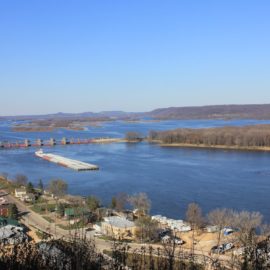
The Corps of Engineers put in 35 year pumps when the post Katrina work was done. Some are bad now.
The Army Corps of Engineers has discovered severe corrosion to a pump at the end of the London Avenue Canal in New Orleans and less corrosion to another at the Orleans Avenue Canal, Corps officials said Tuesday, with plans to repair both elements of the city’s vital flood protection system by the June 1 beginning of hurricane season. In addition to the temporary repairs, the Corps is also planning a deeper look at the city’s combined permanent canal closure and pump stations to determine whether there are design flaws only five years after completion.
nola.com
The problem was discovered after an overheating was noticed.
The corrosion of the London Avenue pump was discovered in February, after water was removed from the bay in which it was built, and its outer covering was removed. It overheated in May 2022 and was taken out of service after being detected during regular maintenance by staff of the Southeast Louisiana Flood Protection Authority-East, which operates those pump stations as well as the 17th Street Canal station as part of the hurricane levee system, said Kelli Chandler, the authority’s regional director. “When the issue was identified, we immediately notified our partners” at the Corps and the state Coastal Protection and Restoration Authority, which is the official local sponsor for the levee system, Chandler said. A Corps spokesperson said more than enough pumping capacity remained at the station to move water into Lake Pontchartrain in the event of a hurricane last year. But at the time, officials thought there might be other reasons for the pump overheating, including the possibility that its equipment became misaligned because the heavy pump station structure was sinking, or that a temperature sensor was faulty.
Some corrosion was expected but not the amount found.
When the pump’s covering was removed in mid-February, inspectors found that the severity of corrosion – only five years after the station’s official 2018 turnover to local authorities as complete – was well beyond what was expected during its entire 35-year service life, said Bradley Drouant, senior project manager for the three lakefront stations. The Corps has hired Lakey Inc. to complete repairs to that pump, at a cost likely to total several hundred thousand dollars, Drouant said, which will be paid for by the federal government using money remaining from funds set aside for construction of the three pump stations. But the damage also was enough to trigger an inspection of all 16 pumps at the three stations, which are designed to move water from the city-side of their respective canals into Lake Pontchartrain when the adjacent surge gates are closed in advance of a hurricane.
The three facilities were turned over to the city in 2018.
The three permanent canal closures and pump stations were completed in 2018 at a cost of $726 million, one of the last projects of the $14.6 billion redesign and construction of the New Orleans area east and west bank hurricane levee system in the wake of Hurricane Katrina. Floodwalls along the London Avenue and 17th Street canals failed because of improper designs during the 2005 storm, resulting in major flooding in areas within the pre-Katrina levee system. As part of the redesign, the stations were meant to keep surge from the lake from entering the city and threatening the interior floodwalls along the canals, while the pumps were designed to match the flow of water entering the canals from interior pump stations in moving it into the lake, even when the lake was high with hurricane surge. Corps officials said Tuesday that a second pump at the London Avenue station also has been targeted for an in-depth inspection because of increased operating temperatures. The good news, Drouant said, is that corrosion found at the first batch of smaller pumps inspected at the Orleans Avenue and 17th Street canal stations is not as significant, though one pump at the Orleans Avenue station did require repairs, at the expense of the stations’ original builder, PCCP Constructors JV.
Checking them means stopping the water and pumping it out as the pumps are underwater,
The inspections are requiring the installation of stoplogs to block water entering each bay where the pumps are located within the stations, so the pumps, most of which usually are under water, can be uncovered and examined. Temporary repairs are expected to be complete before June 1. But the Corps also has begun what it terms a “long-term repairs” strategy aimed at a more comprehensive review of whether the design of the pumps was deficient, including a review of the ability of the metals used in their construction to withstand corrosion throughout their 35-year design life. A contract for that review has not been finalized, but is expect to take at least two years, and will require the identification of a funding source.

(Army Corps of Engineers)
Alternative options are being considered.
The Corps also is evaluating alternatives for removing water from the canals in the event pump capacity at individual stations drops below what is needed during hurricanes. Water levels in each canal are limited to no higher than 8 feet above sea level to protect floodwalls. One alternative would simply delay when the gates at canals are closed, based on water levels in Lake Pontchartrain, which are an average 1 foot above sea level without storms. At London Avenue, the gates would be closed when lake levels are 4.5 feet and rising, instead of 3 feet; they would be closed when levels are at 5 feet and rising, instead of 4 feet, at the 17th Street and Orleans Avenue canals. A second alternative would include the installation of temporary pumps at one or more of the stations, where they would suck water out of the canal and pump it over the gate structure into the lake. A third alternative could include both options. “In the short term, we want to make sure that all the stations are operating during this hurricane season,” said Corps spokesperson Ricky Boyett. “In the long term, we are leveraging the entire Corps to ensure we can bring these pumps to their specified design life. When we’re looking at the long-term alternatives, we will undertake that work outside the hurricane season.”
A 35 year pump should be built with metal that lasts 35 years. Where is the manufacture who should be held accountable.



